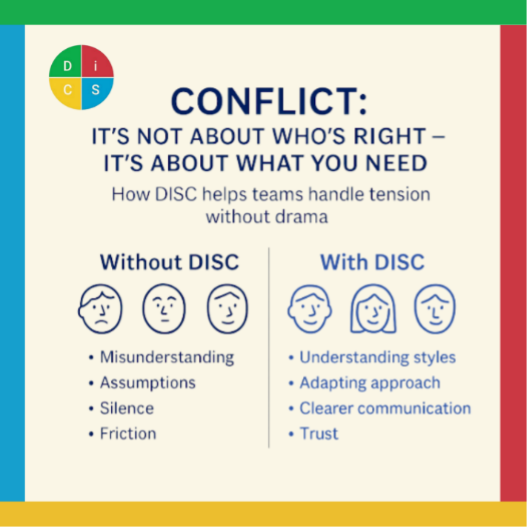
By Sandra Rowell: Associate of DISCsimple
A project deadline was looming.
The manager wanted a fast decision.
The analyst wanted more data.
The team member just wanted everyone to calm down.
No shouting, no slammed doors, but the tension was real. Sound familiar?
Conflict in the workplace is inevitable, but it doesn’t have to be destructive. When managed well, it becomes one of the most powerful drivers of innovation, collaboration, and trust.
The real challenge? Not everyone handles conflict the same way.
Some confront it head-on.
Others retreat.
Some smile while quietly avoiding it.
This is where DISC transforms the picture.
Why Conflict Isn’t the Enemy
Conflict is feedback. It signals that something matters, something isn’t aligned, or something needs clarity.
Handled well, conflict can lead to:
- Stronger relationships
- Clearer communication
- Better decisions
- Greater mutual respect
The key is not avoiding the discomfort but learning to lean into it with awareness of your own style and others’.
How DISC Styles Handle Conflict
D Style (Dominance)
- Strengths: Direct, decisive, results-driven
- Conflict Style: Confronts fast, sometimes bluntly
- Risk: Can bulldoze or dismiss others
- Growth Tip: Pause and listen fully before pushing ahead
I Style (Influence)
- Strengths: Optimistic, people-focused
- Conflict Style: May sugarcoat or avoid to keep things light
- Risk: Deflects hard conversations
- Growth Tip: Lean into honesty and hold firm boundaries
S Style (Steadiness)
- Strengths: Loyal, cooperative, calm
- Conflict Style: Avoids, internalises stress
- Risk: Bottled emotions, silent resentment
- Growth Tip: Use “I feel” statements, speak up early
C Style (Conscientiousness)
- Strengths: Analytical, detail-driven
- Conflict Style: Withdraws, focuses on logic
- Risk: Overly critical, emotionally distant
- Growth Tip: Acknowledge feelings, connect with empathy
Spotting Conflict Before It Erupts
Conflict doesn’t always show up as shouting or slammed doors. In fact, much of it simmers silently. Being DISC-aware helps us identify the signs and act before things escalate.
Watch for:
- Missed deadlines
- Short replies
- Passive resistance
- “All good” masking frustration
With DISC awareness, you can spot these signs early and act before things boil over.
Using DISC to De-Escalate
Here are practical shifts each style can make when tension rises:
| Your Style | Conflict Tip |
| D |
Ask clarifying questions before asserting. Let others speak without interruption. |
| I |
Stay with the facts. Not everything needs to feel good. |
| S | Don’t avoid — script your points, use facts to back feelings. |
| C | People aren’t logic puzzles — acknowledge emotions too. |
Some Real-Life Examples
|
D-style vs S-style Scenario: A D-style manager pushes aggressively for faster decisions and immediate change. The S-style team member feels overwhelmed, undervalued, and fearful of conflict, but doesn’t speak up. Without DISC:
With DISC: They realise:
Result: The S feels more empowered to contribute, and the D learns to lead without bulldozing. |
|
I-style vs C-style Scenario: An I-style team leader keeps promising things that a C-style colleague finds unrealistic. The C feels frustrated by the lack of detail and accountability. The I feels micromanaged and criticised. Without DISC: They clash repeatedly. · The I needs to slow down, clarify commitments, and welcome challenge. · The C needs to soften tone, show appreciation, and allow some flexibility. Result: A working relationship built on mutual understanding, not assumptions. |
|
S-style vs I-style Scenario: An S-style coordinator wants to follow a steady, proven process. The I-style colleague thrives on spontaneity and constantly changes the plan, causing anxiety for the S. Without DISC:
With DISC: They realise:
Result: The S gets the predictability they need, and the I still feels energised but within healthy boundaries. |
|
C-style vs D-style Scenario: A C-style technical expert flags concerns about compliance and accuracy, which the D-style decision-maker views as barriers to momentum. The C feels dismissed, and the D feels bogged down. Without DISC:
With DISC: They realise:
Result: Deadlines are met without compromising quality and the team benefits from both speed and accuracy. |
Conflict Is Inevitable. Drama Is Optional.
Teams that use DISC proactively:
- Prevent misunderstandings
- Build trust faster
- Strengthen feedback culture
- Create psychological safety
So next time tension rises, pause and ask yourself:
- “What style might this person be?”
- “How can I adapt to connect, not clash?”
Conflict can feel uncomfortable. But with DISC, it doesn’t have to be unpredictable.
Ready to Navigate Conflict with Confidence?
Discover how DISC Catalyst and tailored team training can shift the way your people connect, challenge, and collaborate — even when pressure is high.
Find out more at by pressing the LINK to book a DISC discovery session with me or contact DISCsimple® at discover@discsimple.com to explore how we can bring DISC into your organisation.
Sources
- Gallup (2023). State of the Global Workplace Report
- Gallup (2024). Employee Engagement and Profitability Meta-Analysis
- Harvard Business Publishing (2024). Global Leadership Development Study
- DISC behavioural patterns aligned with: Everything DiSC®, DISC Flow®, TTI Success Insights®, DISCsimple® (applied within Sandra Rowell Coaching)
